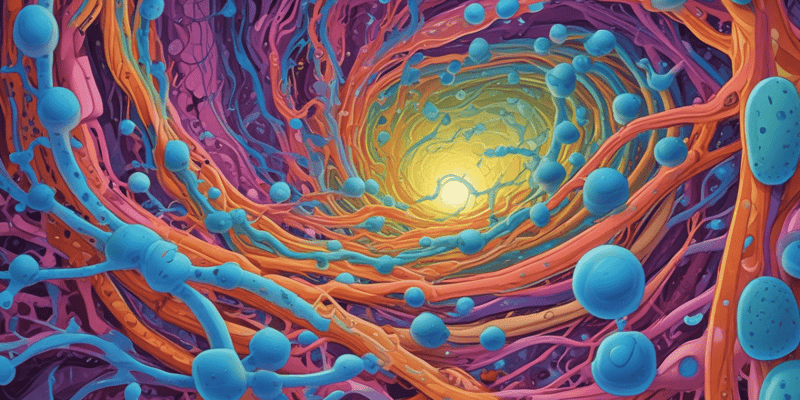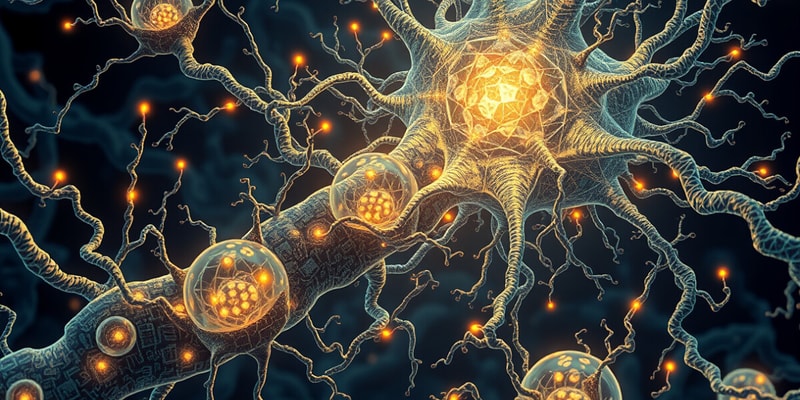Podcast
Questions and Answers
What is the approximate number of calcium ions that can pass into the cell before a sodium ion mistakenly enters?
What is the approximate number of calcium ions that can pass into the cell before a sodium ion mistakenly enters?
What are the three factors that determine whether an ion will flow through an ion channel?
What are the three factors that determine whether an ion will flow through an ion channel?
What is the equation that allows us to calculate the equilibrium potential for an ion?
What is the equation that allows us to calculate the equilibrium potential for an ion?
What is the direction of potassium ion flow across the membrane to take the membrane potential from -60mV to EK+?
What is the direction of potassium ion flow across the membrane to take the membrane potential from -60mV to EK+?
Signup and view all the answers
What is the equilibrium potential for sodium ions?
What is the equilibrium potential for sodium ions?
Signup and view all the answers
What is the term for the 'steepness' of the electrochemical gradient?
What is the term for the 'steepness' of the electrochemical gradient?
Signup and view all the answers
What is the purpose of the selectivity filter in an ion channel?
What is the purpose of the selectivity filter in an ion channel?
Signup and view all the answers
What would happen to the membrane potential if an ion channel suddenly becomes permeable to an ion?
What would happen to the membrane potential if an ion channel suddenly becomes permeable to an ion?
Signup and view all the answers
What is the primary function of ion channels in a cell?
What is the primary function of ion channels in a cell?
Signup and view all the answers
What is the result of ionic currents flowing across the cell membrane through ion channels?
What is the result of ionic currents flowing across the cell membrane through ion channels?
Signup and view all the answers
What is a common feature of ion channels?
What is a common feature of ion channels?
Signup and view all the answers
What is a structural requirement for ion channels?
What is a structural requirement for ion channels?
Signup and view all the answers
What type of protein forms ion channels?
What type of protein forms ion channels?
Signup and view all the answers
What is the function of the 4th transmembrane α-helix in a voltage-dependent potassium channel?
What is the function of the 4th transmembrane α-helix in a voltage-dependent potassium channel?
Signup and view all the answers
What is the structure of the nicotinic ACh receptor?
What is the structure of the nicotinic ACh receptor?
Signup and view all the answers
What is a characteristic of the voltage-gated potassium channel?
What is a characteristic of the voltage-gated potassium channel?
Signup and view all the answers
What is the direction of the potassium current at a membrane potential of -120 mV?
What is the direction of the potassium current at a membrane potential of -120 mV?
Signup and view all the answers
What happens to the potassium current at a membrane potential of -90 mV?
What happens to the potassium current at a membrane potential of -90 mV?
Signup and view all the answers
What is the equilibrium potential for potassium ions?
What is the equilibrium potential for potassium ions?
Signup and view all the answers
Why does the potassium current reverse direction at -60 mV and -120 mV?
Why does the potassium current reverse direction at -60 mV and -120 mV?
Signup and view all the answers
What determines the direction of the potassium current?
What determines the direction of the potassium current?
Signup and view all the answers
What is the relationship between the electrochemical driving force and the direction of the potassium current?
What is the relationship between the electrochemical driving force and the direction of the potassium current?
Signup and view all the answers
What is the primary purpose of voltage-dependent sodium and voltage-dependent calcium channels in nerve cells?
What is the primary purpose of voltage-dependent sodium and voltage-dependent calcium channels in nerve cells?
Signup and view all the answers
What is the approximate membrane potential above which voltage-dependent Na+ channels open to trigger an action potential?
What is the approximate membrane potential above which voltage-dependent Na+ channels open to trigger an action potential?
Signup and view all the answers
What is the primary function of the dendrites in a nerve cell?
What is the primary function of the dendrites in a nerve cell?
Signup and view all the answers
What is the term for the rapid change in the membrane potential of a nerve cell that allows it to transmit information?
What is the term for the rapid change in the membrane potential of a nerve cell that allows it to transmit information?
Signup and view all the answers
What is the region of the nerve cell where the action potential is initiated?
What is the region of the nerve cell where the action potential is initiated?
Signup and view all the answers
What is the primary function of the cell body in a nerve cell?
What is the primary function of the cell body in a nerve cell?
Signup and view all the answers
What is the term for the gaps between nerve cells where chemical communication occurs?
What is the term for the gaps between nerve cells where chemical communication occurs?
Signup and view all the answers
What determines whether a nerve cell is communicating with others in the network?
What determines whether a nerve cell is communicating with others in the network?
Signup and view all the answers
What is a key characteristic of voltage-dependent sodium channels that is essential to describe them accurately?
What is a key characteristic of voltage-dependent sodium channels that is essential to describe them accurately?
Signup and view all the answers
Which of the following is NOT a way to classify ion channels?
Which of the following is NOT a way to classify ion channels?
Signup and view all the answers
What is the main role of ion channels in determining the membrane potential?
What is the main role of ion channels in determining the membrane potential?
Signup and view all the answers
What is a characteristic of ligand-gated ion channels?
What is a characteristic of ligand-gated ion channels?
Signup and view all the answers
What is the result of membrane depolarization?
What is the result of membrane depolarization?
Signup and view all the answers
Which of the following ion channels is NOT voltage-gated?
Which of the following ion channels is NOT voltage-gated?
Signup and view all the answers
What is the purpose of drawing a simple diagram of the protein structure of ion channels?
What is the purpose of drawing a simple diagram of the protein structure of ion channels?
Signup and view all the answers
What is the result of opening or closing ion channels?
What is the result of opening or closing ion channels?
Signup and view all the answers
Study Notes
Ion Channels
- Ion channels are formed by transmembrane proteins and are characterized by passive selective permeability and gated control.
- They allow ions to flow across the cell membrane in response to stimuli.
- Ionic currents flowing across the membrane through ion channels lead to changes in the cell membrane potential, which in turn bring about changes in cell activity.
Structural Requirements for Ion Channels
- A pore
- A selectivity filter
- A sensor of some description
- One or more gates
Types of Ion Channels
- Voltage-gated ion channels (e.g., voltage-dependent potassium channels, voltage-dependent sodium channels)
- Ligand-gated ion channels (e.g., nicotinic ACh receptors, GABAA receptors, 5HT3 receptors)
- Receptor-gated ion channels (e.g., nicotinic ACh receptor)
Voltage-Gated Ion Channels
- The archetypal voltage-gated potassium channel is formed by a single polypeptide with a similar predicted structure to a single domain of the voltage-gated sodium channel.
- The protein contains 6 transmembrane spanning α-helices and a 'P' loop.
- The 4th transmembrane α-helix is a voltage sensor.
Ion Flow and Electrochemical Gradient
- The electrochemical driving force is the difference between the membrane potential (Vm or Em) and the equilibrium potential (Eeq) for that ion.
- The Nernst equation allows us to calculate the equilibrium potential for an ion.
Ion Flow Examples
- At a membrane potential of -60 mV, the electrochemical driving force is +30 mV, pushing potassium ions out of the cell.
- At a membrane potential of -120 mV, the electrochemical driving force is -30 mV, pushing potassium ions into the cell.
- At a membrane potential of -90 mV, the electrochemical driving force is 0 mV, and there is no current.
Ion Channels in Nerve Cells
- Ion channels play a critical role in nerve cell communication, determining whether a nerve cell is communicating with others in the network.
- Voltage-dependent sodium and voltage-dependent calcium channels are essential for nerve cell communication.
- Depolarization of the membrane potential is an excitatory event, leading to an action potential.
Action Potential and Nerve Cell Communication
- The action potential threshold (approx. -55mV) is the membrane potential above which voltage-dependent Na+ channels open to trigger an all-or-nothing action potential.
- The action potential is propagated from the cell body, along the axon, to the nerve terminal, releasing neurotransmitters onto other cells to pass on information.
Features of a Typical Nerve Cell
- Dendrites receive information from other neurons.
- The cell body contains the nucleus and drives maintenance and metabolism, integrating the information received by the dendrites.
- The axon terminals release neurotransmitters onto other cells to pass on information.
- The axon hillock is where the action potential is initiated.
Studying That Suits You
Use AI to generate personalized quizzes and flashcards to suit your learning preferences.
Related Documents
Description
This quiz covers the structure and function of ion channels, including their selective permeability and gating mechanisms, and how they affect cell membrane potential and activity.




